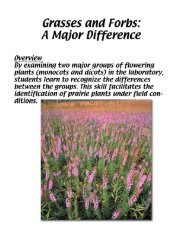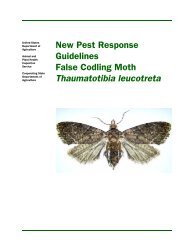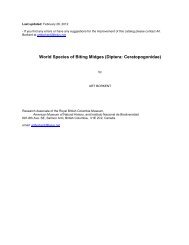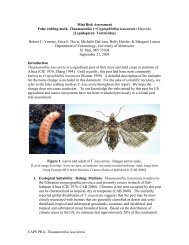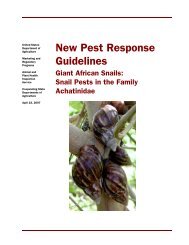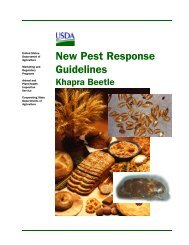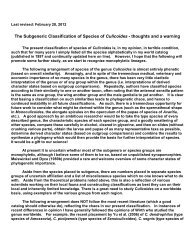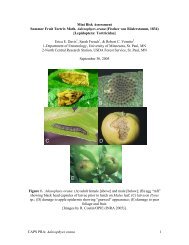Dramatically elevated rate of mitochondrial substitution in lice ...
Dramatically elevated rate of mitochondrial substitution in lice ...
Dramatically elevated rate of mitochondrial substitution in lice ...
Create successful ePaper yourself
Turn your PDF publications into a flip-book with our unique Google optimized e-Paper software.
Molecular Phylogenetics and Evolution 26 (2003) 231–242MOLECULARPHYLOGENETICSANDEVOLUTIONwww.elsevier.com/locate/ympev<strong>Dramatically</strong> <strong>elevated</strong> <strong>rate</strong> <strong>of</strong> <strong>mitochondrial</strong> <strong>substitution</strong><strong>in</strong> <strong>lice</strong> (Insecta: Phthiraptera)Kev<strong>in</strong> P. Johnson, a, *Robert H. Cruickshank, b Richard J. Adams, cV<strong>in</strong>cent S. Smith, b Roderic D.M. Page, b and Dale H. Clayton ca Ill<strong>in</strong>ois Natural History Survey, 607 East Peabody Drive, Champaign, IL 61820, USAb Division <strong>of</strong> Environmental and Evolutionary Biology, Institute <strong>of</strong> Biomedical and Life Sciences, University <strong>of</strong> Glasgow, Glasgow G12 8QQ, UKc Department <strong>of</strong> Biology, University <strong>of</strong> Utah, Salt Lake City, UT, USAReceived 1 April 2002; revised 6 August 2002AbstractFew estimates <strong>of</strong> relative <strong>substitution</strong> <strong>rate</strong>s, and the underly<strong>in</strong>g mutation <strong>rate</strong>s, exist between <strong>mitochondrial</strong> and nuclear genes <strong>in</strong><strong>in</strong>sects. Previous estimates for <strong>in</strong>sects <strong>in</strong>dicate a 2–9 times faster <strong>substitution</strong> <strong>rate</strong> <strong>in</strong> <strong>mitochondrial</strong> genes relative to nuclear genes.Here we use novel methods for estimat<strong>in</strong>g relative <strong>rate</strong>s <strong>of</strong> <strong>substitution</strong>, which <strong>in</strong>corpo<strong>rate</strong> multiple <strong>substitution</strong>s, and apply thesemethods to a group <strong>of</strong> <strong>in</strong>sects (<strong>lice</strong>, Order: Phthiraptera). First, we use a modification <strong>of</strong> copath analysis (branch length regression)to construct <strong>in</strong>dependent comparisons <strong>of</strong> <strong>rate</strong>s, consist<strong>in</strong>g <strong>of</strong> each branch <strong>in</strong> a phylogenetic tree. The branch length comparisons usemaximum likelihood models to correct for multiple <strong>substitution</strong>. In addition, we estimate codon-specific <strong>rate</strong>s under maximumlikelihood for the different genes and compare these values. Estimates <strong>of</strong> the relative synonymous <strong>substitution</strong> <strong>rate</strong>s between a<strong>mitochondrial</strong> (COI) and nuclear (EF-1a) gene <strong>in</strong> <strong>lice</strong> <strong>in</strong>dicate a relative <strong>rate</strong> <strong>of</strong> several 100 to 1. This rapid relative <strong>mitochondrial</strong><strong>rate</strong> (>100 times) is at least an order <strong>of</strong> magnitude faster than previous estimates for any group <strong>of</strong> organisms. Comparisons us<strong>in</strong>g thesame methods for another group <strong>of</strong> <strong>in</strong>sects (aphids) reveals that this extreme relative <strong>rate</strong> estimate is not simply attributable to themethods we used, because estimates from aphids are substantially lower. Taxon sampl<strong>in</strong>g affects the relative <strong>rate</strong> estimate, withcomparisons <strong>in</strong>volv<strong>in</strong>g more closely related taxa result<strong>in</strong>g <strong>in</strong> a higher estimate. Relative <strong>rate</strong> estimates also <strong>in</strong>crease with modelcomplexity, <strong>in</strong>dicat<strong>in</strong>g that methods account<strong>in</strong>g for more multiple <strong>substitution</strong> estimate higher relative <strong>rate</strong>s.Ó 2002 Elsevier Science (USA). All rights reserved.Keywords: Substitution <strong>rate</strong>s; Phthiraptera; Lice; Insecta; COI; Elongation factor-1 a1. IntroductionThe <strong>elevated</strong> <strong>rate</strong> <strong>of</strong> <strong>substitution</strong> <strong>in</strong> <strong>mitochondrial</strong>DNA relative to nuclear DNA <strong>in</strong> animals is widely appreciated.Several studies have <strong>in</strong>dicated an <strong>elevated</strong> <strong>rate</strong><strong>of</strong> <strong>substitution</strong>, probably ow<strong>in</strong>g to underly<strong>in</strong>g differences<strong>in</strong> mutation <strong>rate</strong>s <strong>in</strong> verteb<strong>rate</strong> <strong>mitochondrial</strong>DNA, compared to comparable nuclear genes (Brownet al., 1979; Johnson and Clayton, 2000; Miyata et al.,1982). The relative <strong>rate</strong> <strong>of</strong> nucleotide <strong>substitution</strong> andmutation <strong>in</strong> <strong>mitochondrial</strong> versus nuclear genes has beenless extensively exam<strong>in</strong>ed <strong>in</strong> <strong>in</strong>sects. However, most* Correspond<strong>in</strong>g author. Fax: 1-217-333-4949.E-mail address: kjohnson@<strong>in</strong>hs.uiuc.edu (K.P. Johnson).studies <strong>in</strong>dicate that <strong>mitochondrial</strong> genes have a <strong>substitution</strong>and mutation <strong>rate</strong> that is 2–9 times faster thannuclear genes (DeSalle et al., 1987; Monteiro and Pierce,2001; Moriyama and Powell, 1997; Satta et al., 1987;Tamura, 1992), and these estimates are similar to thosefor verteb<strong>rate</strong>s. Studies compar<strong>in</strong>g <strong>rate</strong>s <strong>of</strong> <strong>mitochondrial</strong><strong>substitution</strong> for parasitic <strong>in</strong>sects and their verteb<strong>rate</strong>hosts have concluded that parasites show a faster<strong>substitution</strong> <strong>rate</strong> than their hosts (Hafner et al., 1994;Page et al., 1998; Paterson et al., 2000). Because all <strong>of</strong>these studies have <strong>in</strong>volved <strong>lice</strong> (Insecta: Phthiraptera),it is unclear whether the <strong>elevated</strong> <strong>mitochondrial</strong> <strong>substitution</strong><strong>rate</strong> is characteristic <strong>of</strong> all <strong>in</strong>sects, or just <strong>lice</strong>.What is needed is a comparison <strong>of</strong> the relative <strong>mitochondrial</strong>to nuclear <strong>substitution</strong> <strong>rate</strong> <strong>in</strong> <strong>lice</strong> versus other<strong>in</strong>sects.1055-7903/02/$ - see front matter Ó 2002 Elsevier Science (USA). All rights reserved.PII: S1055-7903(02)00342-1
232 K.P. Johnson et al. / Molecular Phylogenetics and Evolution 26 (2003) 231–242Estimat<strong>in</strong>g the relative <strong>rate</strong> <strong>of</strong> <strong>substitution</strong> or mutationbetween nuclear and <strong>mitochondrial</strong> genes is not asstraightforward as it might at first appear. First, variation<strong>in</strong> selective constra<strong>in</strong>ts between different gene regionsmight lead to differences <strong>in</strong> the <strong>substitution</strong> <strong>rate</strong>s.For example, such differences are known to occur between<strong>mitochondrial</strong> prote<strong>in</strong> cod<strong>in</strong>g genes (Jacobs et al.,1988; M<strong>in</strong>dell and Thacker, 1996) and would affect estimates<strong>of</strong> relative <strong>rate</strong>s <strong>of</strong> molecular evolution between<strong>mitochondrial</strong> and nuclear genes. Ideally, estimates <strong>of</strong>mutation should be derived from neutral sites becausetheir <strong>substitution</strong> <strong>rate</strong>s should directly reflect underly<strong>in</strong>gmutation <strong>rate</strong>s (Kimura, 1962).Another potential concern is that, for comparisonsbetween species, rapidly evolv<strong>in</strong>g loci are expected toundergo many multiple <strong>substitution</strong>s (Li, 1997). Methodsthat do not account for multiple <strong>substitution</strong> arelikely to underestimate the actual genetic divergence andthus potentially bias the estimate <strong>of</strong> the relative <strong>substitution</strong><strong>rate</strong>s. Methods that rely on simple genetic distancesor parsimony reconstruction are likely to misssuch multiple <strong>substitution</strong>s (Johnson and Sorenson,1998; Sanderson, 1990).Here we use two methods for estimat<strong>in</strong>g the relative<strong>rate</strong>s <strong>of</strong> <strong>mitochondrial</strong> and nuclear mutation. The firstmethod is analogous to copath analysis, previously developedfor comparison <strong>of</strong> host-parasite <strong>rate</strong>s (Page,1996). Copath analysis takes advantage <strong>of</strong> the many<strong>in</strong>dependent comparisons that can be gleaned from alarge phylogeny, us<strong>in</strong>g branches common to two phylogenies.In the case <strong>of</strong> relative <strong>rate</strong>s between genes,branch lengths for various gene regions are estimatedfor each branch <strong>in</strong> the tree, preferably us<strong>in</strong>g a methodthat accounts for multiple <strong>substitution</strong>. The lengths <strong>of</strong>the branches for the two genes are compared <strong>in</strong> a regressionanalysis to estimate the relative <strong>substitution</strong><strong>rate</strong>s (Page, 1996; Paterson et al., 2000). We assume thatthe same species phylogeny underlies both genes(Maddison, 1997; Pamilo and Nei, 1988; Slow<strong>in</strong>ski andPage, 1999), such that branches <strong>in</strong> a species phylogenyare analogous to copaths.To correct for multiple <strong>substitution</strong>s, we use a maximumlikelihood framework (Felsenste<strong>in</strong>, 1981; Huelsenbeckand Crandall, 1997). Branch lengths for the twogene regions are estimated under a maximum likelihoodmodel. Likelihood models directly <strong>in</strong>corpo<strong>rate</strong> multiple<strong>substitution</strong>s when estimat<strong>in</strong>g branch lengths, so thisprocedure has the best chance <strong>of</strong> m<strong>in</strong>imiz<strong>in</strong>g unrecoveredmultiple <strong>substitution</strong>s that could compromise the <strong>rate</strong>comparison. To evaluate the effect <strong>of</strong> functional constra<strong>in</strong>tson the relative <strong>rate</strong> estimate, we conduct thebranch length regression us<strong>in</strong>g only third sites and comparethis to the estimate from all sites. S<strong>in</strong>ce the majority<strong>of</strong> third position <strong>substitution</strong>s are synonymous, analysis<strong>of</strong> only third positions will m<strong>in</strong>imize the impact <strong>of</strong> potentiallyselected am<strong>in</strong>o acid replacement <strong>substitution</strong>s.For the second method, we fit likelihood models tothe two genes and test whether they show a significantlydifferent <strong>rate</strong> us<strong>in</strong>g likelihood ratio tests. In addition, wetest for site specific (codon position) <strong>rate</strong>s us<strong>in</strong>g likelihoodratio tests and compare the <strong>rate</strong> parameters betweengenes. We also test whether the branch lengths forthe two different genes are proportional. This method isfundamentally different than the regression <strong>of</strong> branchlengths, and provides a comparison to the branch lengthmethod.For the <strong>rate</strong> comparison presented here, we evaluatethe relative <strong>rate</strong>s <strong>of</strong> <strong>substitution</strong> for a portion <strong>of</strong> thenuclear gene elongation factor-1 alpha (EF-1a) and aportion <strong>of</strong> the <strong>mitochondrial</strong> gene cytochrome oxidase I(COI) for <strong>lice</strong> (Phthiraptera). We evaluate the effect <strong>of</strong>taxonomic sampl<strong>in</strong>g by compar<strong>in</strong>g a data set for 150species, <strong>in</strong>clud<strong>in</strong>g no more than three species from anyone genus, to two groups <strong>of</strong> dove <strong>lice</strong> that both <strong>in</strong>cludemany species from the same genus (Johnson and Clayton,2002). We compare the estimates for <strong>lice</strong> with those<strong>of</strong> other paraneopteran <strong>in</strong>sects for the same two genes.2. Materials and methods2.1. Samples and sequenc<strong>in</strong>gWe obta<strong>in</strong>ed 150 species <strong>of</strong> bird and mammal <strong>lice</strong>,<strong>in</strong>clud<strong>in</strong>g representatives <strong>of</strong> all four suborders, us<strong>in</strong>gethyl acetate fumigation (Clayton et al., 1992). From<strong>in</strong>dividual <strong>lice</strong>, we extracted DNA by remov<strong>in</strong>g the headfrom the body <strong>of</strong> the louse and plac<strong>in</strong>g both <strong>in</strong> a digestionbuffer from a Qiagen Tissue Extraction kit. Extractionwas completed accord<strong>in</strong>g to manufacturerÕsprotocols. After extraction, the head and body <strong>of</strong> eachlouse were mounted together on a microslide as a voucher.Vouchers were deposited <strong>in</strong> the Price Institute <strong>of</strong>Phthirapteran Research (University <strong>of</strong> Utah) or theUniversity <strong>of</strong> Glasgow.We amplified, us<strong>in</strong>g PCR, portions <strong>of</strong> the COI andEF-1a genes from each extract. For COI we used theprimers L6625 and H7005 (Hafner et al., 1994) and forEF-1a the primers EF1-For3 and Cho10 (Danforth andJi, 1998). PCR and sequenc<strong>in</strong>g were performed as describedpreviously (Cruickshank et al., 2001; Johnsonand Clayton, 2000). Sequences for complementarychromatograms were resolved and then aligned acrossspecies us<strong>in</strong>g the computer program Sequencher 3.0(GeneCodes) or Sequence Navigator. Many <strong>of</strong> the EF-1a sequences were published previously (Cruickshanket al., 2001) and new sequences for EF-1a and COI weredeposited <strong>in</strong> GenBank (Accession Numbers AF545666–AF545809).To test the effects <strong>of</strong> taxon sampl<strong>in</strong>g, we used twopreviously published data sets <strong>of</strong> EF-1a and COI sequences<strong>in</strong> <strong>lice</strong>: Columbicola and Physconelloid<strong>in</strong>ae
K.P. Johnson et al. / Molecular Phylogenetics and Evolution 26 (2003) 231–242 233(Johnson and Clayton, 2002). These data sets conta<strong>in</strong> 15and 18 closely related taxa, respectively. As a comparisonto other <strong>in</strong>sects, we used a published data set for 14closely related species <strong>of</strong> aphids (Hemiptera: Uroleucon)for the same genes (Moran et al., 1999). Aphid sequencesfor EF-1a were unavailable for the same regionas the louse EF-1a sequences, but comparisons <strong>of</strong> <strong>rate</strong>variation among exons <strong>of</strong> EF-1a for aphids revealedlittle <strong>rate</strong> variation, so we selected an exon <strong>of</strong> similar size(exon 1), for comparison with the louse data.2.2. Phylogenetic analysisTo compare <strong>rate</strong>s, we used maximum likelihood(ML) to estimate branch lengths us<strong>in</strong>g PAUP* (Sw<strong>of</strong>ford,2001). Maximum likelihood models take <strong>in</strong>to accountmultiple <strong>substitution</strong>s and thus are more likely toaccu<strong>rate</strong>ly estimate the number <strong>of</strong> <strong>substitution</strong>s s<strong>in</strong>ce anancestor along a branch. However, because f<strong>in</strong>d<strong>in</strong>g theoptimal tree for 150 taxa under maximum likelihood isextremely computationally <strong>in</strong>tensive, we chose to usephylogenetic estimates obta<strong>in</strong>ed from neighbor jo<strong>in</strong><strong>in</strong>g<strong>of</strong> comb<strong>in</strong>ed COI and EF-1a data (uncorrected distances).We rooted trees for Phthiraptera us<strong>in</strong>g species<strong>in</strong> the suborder Amblycera as <strong>in</strong>dicated by Lyal (1985)and Johnson and Whit<strong>in</strong>g (2002).Direct comparison <strong>of</strong> branch lengths, as <strong>in</strong> copathanalysis, relies on the same underly<strong>in</strong>g phylogeny for allthe paths. This is the species phylogeny, and we feel thatthis is best estimated by comb<strong>in</strong>ed analysis <strong>in</strong> this case.We used a partition homogeneity test (Farris et al.,1994, 1995; Sw<strong>of</strong>ford, 2001) and compared 50% bootstraptrees (Felsenste<strong>in</strong>, 1985) between COI and EF-1afor the 150 species <strong>of</strong> Phthiraptera to evaluate whether asimilar phylogeny underlies both genes. A partitionhomogeneity test <strong>in</strong>dicated significant heterogeneitybetween COI and EF-1a data sets (P ¼ 0:01). However,no node conflicted at >60% bootstrap support betweentrees constructed from parsimony analysis <strong>of</strong> the twogenes <strong>in</strong>dependently. Evaluations <strong>of</strong> the performance <strong>of</strong>the partition homogeneity test with the same underly<strong>in</strong>gphylogeny, but <strong>in</strong>volv<strong>in</strong>g data sets <strong>of</strong> different <strong>rate</strong>s(Barker and Lutzoni, 2002; Darlu and Leco<strong>in</strong>tre, 2002;Dolph<strong>in</strong> et al., 2000), <strong>in</strong>dicate that when <strong>rate</strong>s betweendata sets are dramatically different, significant heterogeneitycan be detected even though there is no difference<strong>in</strong> the phylogenies underly<strong>in</strong>g the data sets (see alsoJohnson and Whit<strong>in</strong>g, 2002 and Johnson et al., 2002).Such an outcome can be detected by exam<strong>in</strong><strong>in</strong>g bootstraptopologies, with the expectation that <strong>in</strong> such cases,bootstrap topologies will not be <strong>in</strong> strong conflict(Barker and Lutzoni, 2002). As we show below, comb<strong>in</strong><strong>in</strong>ggenes, even <strong>in</strong> the presence <strong>of</strong> heterogeneity, doesnot appear to affect the estimate <strong>of</strong> relative <strong>substitution</strong><strong>rate</strong>s, because data sets with congruent signal providesimilar <strong>rate</strong> estimates. In addition, the dramatic difference<strong>in</strong> <strong>rate</strong>s that we estimate below is likely to havecaused the detection <strong>of</strong> significant heterogeneity by thepartition homogeneity test.We estimated the relative <strong>rate</strong>s <strong>of</strong> <strong>substitution</strong> at thirdsites for COI and EF-1a us<strong>in</strong>g several different likelihoodmodels. First, to provide the most parameter <strong>in</strong>tensiveestimate <strong>of</strong> branch lengths, we fit the mostgeneral maximum likelihood model (general time reversible,<strong>rate</strong> heterogeneity under a c distribution witheight <strong>rate</strong> categories, and <strong>in</strong>variant sites [GTR + G + I])to third sites for both COI and EF-1a. We estimatedbranch lengths us<strong>in</strong>g the NJ tree topology for all sitesand for third sites only, with ML parameters estimatedsepa<strong>rate</strong>ly <strong>in</strong> both cases. We estimated the relative<strong>substitution</strong> <strong>rate</strong>s for COI compared to EF-1a (thirdsites and all sites) us<strong>in</strong>g reduced major axis regression.Reduced major axis regression should be used whenboth x and y variables are estimated with error(McArdle, 1988). The slope <strong>of</strong> the reduced major axisregression is the ratio <strong>of</strong> standard deviations <strong>of</strong> estimatedbranch lengths. Because reduced major axis regressiondoes not pair identical branches per se, rather<strong>in</strong>volves the overall variance <strong>of</strong> branch lengths, we alsoestimated relative <strong>rate</strong>s under ord<strong>in</strong>ary least squaresregression <strong>of</strong> COI branch lengths on EF-1a branchlengths. All least squares regressions were forcedthrough the orig<strong>in</strong>, because a branch length <strong>of</strong> zero forone gene should correspond to a branch length <strong>of</strong> zer<strong>of</strong>or the other gene. In all cases, regression produced ahighly significant correlation <strong>in</strong> branch lengths (allP < 0:001).Branch length estimates may be sensitive to themaximum likelihood model chosen for analysis. Thus, <strong>in</strong>addition to us<strong>in</strong>g the parameter-rich (GTR + G + I)model, we also estimated branch lengths under themodel favored by likelihood ratio tests (Huelsenbeckand Crandall, 1997), us<strong>in</strong>g the simplest model that couldnot be rejected <strong>in</strong> favor <strong>of</strong> a more complex model. Weused the hierarchical likelihood ratio tests procedure asimplemented <strong>in</strong> the program Modeltest (Posada andCrandall, 1998). Aga<strong>in</strong> we estimated these models foreach gene <strong>in</strong>dependently, for third sites only and for allsites. F<strong>in</strong>ally, to evaluate the role <strong>of</strong> unequal <strong>substitution</strong>types, base frequencies, and <strong>rate</strong> heterogeneity <strong>in</strong>relative <strong>rate</strong> estimates, we used the simplest maximumlikelihood model (Jukes and Cantor, 1969) to estimatebranch lengths (aga<strong>in</strong> for both third sites only and allsites).For previously published data sets (Johnson andClayton, 2002; Moran et al., 1999), we used the reportedphylogenetic trees based on all the data over which toestimate branch lengths for particular genes and codonpositions. In the case <strong>of</strong> Columbicola and aphids, this<strong>in</strong>volved additional genes beyond COI and EF-1a. Weestimated branch lengths us<strong>in</strong>g all the data partitionsand maximum likelihood models described above, with
234 K.P. Johnson et al. / Molecular Phylogenetics and Evolution 26 (2003) 231–242both regression techniques. All <strong>rate</strong>s are reported asCOI (<strong>mitochondrial</strong>), relative to EF-1a (nuclear).We supplemented the comparison <strong>of</strong> branch lengthsby perform<strong>in</strong>g a series <strong>of</strong> likelihood analyses us<strong>in</strong>gprogram baseml from the PAML 3.0a package (Yang,1997). PAML allows data to be partitioned <strong>in</strong>to differentgenes or codon positions and a <strong>rate</strong> parameter estimatedfor each partition <strong>in</strong>dependently. Because <strong>of</strong> thecomputationally <strong>in</strong>tensive nature <strong>of</strong> these analyses werestricted our analysis to the Columbicola, Physconelloid<strong>in</strong>ae,and aphid data sets. For each data set weconstructed series <strong>of</strong> progressively less restrictive modelsand <strong>in</strong>ferred the maximum likelihood branch lengths <strong>of</strong>the same phylogeny used <strong>in</strong> the branch length regressionanalyses. The most restrictive model treated the COIand EF-1a sequences as a s<strong>in</strong>gle gene evolv<strong>in</strong>g at thesame overall <strong>rate</strong> (this is model 0 <strong>in</strong> Table 2 <strong>of</strong> Yang(1996) and corresponds to sett<strong>in</strong>g Mgene ¼ 0 <strong>in</strong> the baseml.ctlfile <strong>in</strong> PAML). We then relaxed this constra<strong>in</strong>tby partition<strong>in</strong>g the data <strong>in</strong>to the two genes, but with theconstra<strong>in</strong>t that branch lengths for the two genes wereproportional (model 3 0 , Mgene ¼ 4). The program basemlreports the relative <strong>rate</strong> <strong>of</strong> evolution <strong>in</strong> the twopartitions with respect to the <strong>rate</strong> <strong>in</strong> the first partition.To account for the different <strong>substitution</strong> <strong>rate</strong>s at thethree codon positions, we performed a third analysiswith a total <strong>of</strong> six partitions, three for each gene. F<strong>in</strong>ally,we relaxed the constra<strong>in</strong>t that branch lengths areproportional across the six partitions (model 4,Mgene ¼ 1). Under this model, PAML does not reportthe relative <strong>rate</strong> <strong>of</strong> <strong>substitution</strong> <strong>in</strong> the different partitions,<strong>in</strong> contrast to model 3 0 <strong>in</strong> which the difference <strong>in</strong><strong>substitution</strong> <strong>rate</strong> is constant across the tree and hencecan be represented by a s<strong>in</strong>gle value. Under model 4,two partitions may evolve at different <strong>rate</strong>s, but those<strong>rate</strong>s may vary across the tree, mak<strong>in</strong>g it harder to describeby a s<strong>in</strong>gle value (<strong>in</strong> the branch length comparisonanalyses we estimated the overall <strong>rate</strong> difference us<strong>in</strong>gregression).We compared the models us<strong>in</strong>g likelihood ratio testsas described by Yang (1996). In each case we computethe deviance 2D‘ ¼ 2ð‘ 1 ‘ 0 Þ, where ‘ 1 is the log likelihood<strong>of</strong> the more general model, and ‘ 0 is the loglikelihood <strong>of</strong> the more restrictive model. The significance<strong>of</strong> the deviance is evaluated as v 2 with the number <strong>of</strong>degrees <strong>of</strong> freedom be<strong>in</strong>g the difference <strong>in</strong> parametersbetween the two models. To test whether <strong>mitochondrial</strong>and nuclear genes are evolv<strong>in</strong>g at different <strong>rate</strong>s wecompared the log-likelihoods for the comb<strong>in</strong>ed and twopartitionanalyses (model 0 and model 3 0 , respectively),which has one degree <strong>of</strong> freedom. Comparison <strong>of</strong> thetwo-gene and two-gene/three-codons models has fourdegrees <strong>of</strong> freedom. Model 4 estimates branch lengthsfor the 2n 3 branches <strong>in</strong> the g unrooted trees for nsequences, where g is the number <strong>of</strong> partitions. Hence,ignor<strong>in</strong>g the sequence <strong>substitution</strong> and <strong>rate</strong> variationamong site parameters, model 4 has p ¼ gð2n 3Þ parameters.Model 3 0 constra<strong>in</strong>s the branch lengths <strong>in</strong> eachpartition to be proportional, hence estimates 2n 3branch lengths and g 1 <strong>rate</strong> ratios, giv<strong>in</strong>gq ¼ 2n þ g 4 parameters. The degrees <strong>of</strong> freedom forcompar<strong>in</strong>g models 4 and 3 0 is p q.In all analyses the REV model <strong>of</strong> sequence <strong>substitution</strong>was used, with among-site variation <strong>in</strong> <strong>rate</strong> modeledus<strong>in</strong>g a c distribution with eight <strong>rate</strong> categories to accountfor many <strong>of</strong> the <strong>substitution</strong> properties <strong>of</strong> thesedata with reasonable computational complexity. Thismodel is a subset <strong>of</strong> the most general model used <strong>in</strong> thePAUP* analyses (GTR + G + I), which has the additionalparameter <strong>of</strong> proportion <strong>of</strong> <strong>in</strong>variant sites (I). Thevalues for the parameters <strong>of</strong> the REV model and c distribution(shape parameter a) were estimated sepa<strong>rate</strong>lyfor each partition (i.e., we allowed the <strong>substitution</strong>process to be different for each partition <strong>of</strong> the data).3. ResultsFor the 150-taxon phthirapteran data set, uncorrectedpairwise divergences for COI ranged from 2.4 to41.5%, while uncorrected divergences for EF-1a rangedfrom 0 to 29.4% (Fig. 1). Neighbor jo<strong>in</strong><strong>in</strong>g produced atree <strong>in</strong>dicat<strong>in</strong>g monophyly <strong>of</strong> all suborders except Ischnocera(Fig. 2). Haematomyzus elephantis Piaget, therepresentative <strong>of</strong> the monogeneric suborder Rhynchophthir<strong>in</strong>a,appeared with<strong>in</strong> Ischnocera. This tree conta<strong>in</strong>edthe branches on which maximum likelihoodbranch lengths were estimated for the 150-taxon dataset. The GTR + G + I likelihood model for COI thirdFig. 1. Plot <strong>of</strong> uncorrected pairwise sequence divergence for COIaga<strong>in</strong>st those for EF-1a us<strong>in</strong>g the 150 species data set.
K.P. Johnson et al. / Molecular Phylogenetics and Evolution 26 (2003) 231–242 235Fig. 2. Neighbor jo<strong>in</strong><strong>in</strong>g tree based on comb<strong>in</strong>ed COI and EF-1a sequences for the 150 taxon Phthiraptera data set. (a) Ischnocera, Rhynchophthir<strong>in</strong>a,and Anoplura; (b) Amblycera.sites and EF-1a third sites produced branch lengths thatdiffered dramatically between the two genes (Table 1).The estimated relative <strong>substitution</strong> <strong>rate</strong>s for third siteswas 610:1 us<strong>in</strong>g reduced major axis regression <strong>of</strong> branchlengths and 438:1 us<strong>in</strong>g least squares regression(P < 0:0001). Consider<strong>in</strong>g all sites, relative <strong>substitution</strong>
236 K.P. Johnson et al. / Molecular Phylogenetics and Evolution 26 (2003) 231–242Fig. 2. (cont<strong>in</strong>ued)Table 1Relative <strong>mitochondrial</strong>/nuclear <strong>rate</strong>s (SE) us<strong>in</strong>g all Phthiraptera (150 taxa)Model Sites Major axis regression Least squares regressionGTR + G + I Third sites 609.7 437:5 28:0Modeltest a Third sites 190.5 141:5 8:7Jukes–Cantor Third sites 2.3 1:8 0:1GTR + G + I All sites 5.5 5:1 0:2Modeltest b All sites 5.1 4:8 0:2Jukes–Cantor All sites 2.2 2:1 0:1a GTR + G (COI) and TIM + G + I (EF-1a).b GTR + G + I (both genes).<strong>rate</strong>s were around 5:1 under the GTR + G + I model(Table 1). Us<strong>in</strong>g the models result<strong>in</strong>g from maximumlikelihood ratio tests from Modeltest, relative <strong>rate</strong> estimatesfor third sites were still high, around one third theestimated <strong>rate</strong>s under the GTR + G + I model. Relative<strong>substitution</strong> <strong>rate</strong>s for all sites under the Modeltestmodels were slightly lower than those under theGTR + G + I model (Table 1). A Jukes–Cantor (Jukesand Cantor, 1969) model resulted <strong>in</strong> greatly reducedrelative <strong>rate</strong> estimates, with similar estimates for thirdsites and all sites (Table 1).For Columbicola, uncorrected pairwise divergencesfor COI ranged from 3.1 to 29.8%, while uncorrecteddivergences for EF-1a ranged from 0 to 11.8%. Estimates<strong>of</strong> relative <strong>rate</strong>s for Columbicola from branchlength regression (Table 2) were similar <strong>in</strong> magnitude tothose for all Phthiraptera. However, the third site relative<strong>rate</strong> estimates for Columbicola were <strong>of</strong>ten higherthan those for all Phthiraptera. Fig. 3 shows branchlengths for third positions <strong>of</strong> the two genes drawn to asimilar scale. Relative <strong>rate</strong> estimates for all sites comb<strong>in</strong>edwere an order <strong>of</strong> magnitude lower than those forthird sites only (Table 2). Aga<strong>in</strong>, relative <strong>rate</strong>s decl<strong>in</strong>edas the likelihood model became simpler. A Jukes–Cantor model produced little difference <strong>in</strong> the estimatedrelative <strong>rate</strong>s based on third sites only and all sites.
K.P. Johnson et al. / Molecular Phylogenetics and Evolution 26 (2003) 231–242 237Table 2Relative <strong>mitochondrial</strong>/nuclear <strong>rate</strong>s (SE) us<strong>in</strong>g Columbicola (15 taxa)Model Sites Major axis regression Least squares regressionGTR + G + I Third sites 599.0 412:1 89:3Modeltest a Third sites 333.8 234:0 50:5Jukes–Cantor Third sites 2.7 2:1 0:6GTR + G + I All sites 58.5 41:9 7:1Modeltest b All sites 44.2 33:4 5:2Jukes–Cantor All sites 2.9 2:6 0:5a HKY + G (COI) and TVMef + G (EF-1a).b TVM + G (COI) and TVMef + G (EF-1a).Fig. 3. Reconstruction <strong>of</strong> ML branch lengths over the Columbicola tree for (a) COI 3rd positions and (b) EF-1a 3rd positions. Scale <strong>in</strong>dicated <strong>in</strong> thefigure. Note that the branches <strong>of</strong> the EF-1a tree should be 30 times shorter to make the trees to the same scale. This was not done because <strong>of</strong> thedifficulty <strong>of</strong> fitt<strong>in</strong>g both trees to scale on the same page. C. ¼ Columbicola.Uncorrected pairwise divergences <strong>of</strong> the two genesfor Physconelloid<strong>in</strong>ae ranged from 3.6 to 19.3% for COIand from 0 to 3.1% for EF-1a. Branch length regressionestimates <strong>of</strong> relative <strong>rate</strong>s us<strong>in</strong>g the Physconelloid<strong>in</strong>aedata set (Table 3) produced similar results to boththe Phthiraptera and Columbicola analyses. However,
238 K.P. Johnson et al. / Molecular Phylogenetics and Evolution 26 (2003) 231–242Table 3Relative <strong>mitochondrial</strong>/nuclear <strong>rate</strong>s (SE) us<strong>in</strong>g Physconelloid<strong>in</strong>ae (18 taxa)Model Sites Major axis regression Least squares regressionGTR + G + I Third sites 1002.8 515:2 197:5Modeltest a Third sites 431.3 219:6 84:3Jukes–Cantor Third sites 9.4 5:1 2:0GTR + G + I All sites 213.2 104:4 37:1Modeltest b All sites 240.3 117:4 41:1Jukes–Cantor All sites 5.1 5:4 1:7a TrN + G (COI) and K81uf + G (EF-1a).b GTR + G + I (COI) and TVMef + G (EF-1a).relative <strong>rate</strong> estimates were generally higher for thePhysconelloid<strong>in</strong>ae data set than for either the Phthirapteraor Columbicola data sets.For aphids, uncorrected pairwise divergences for COIranged from 0.8 to 5.8%, while uncorrected divergencesfor EF-1a ranged from 0 to 3.6%. In contrast to thethree louse data sets, estimates <strong>of</strong> the relative <strong>rate</strong>s us<strong>in</strong>gbranch length regression <strong>of</strong> the aphid data set producedmarkedly lower estimates (Table 4). Relative <strong>rate</strong> estimatesfor third sites <strong>in</strong> aphids us<strong>in</strong>g the most complexlikelihood models were around an order <strong>of</strong> magnitudelower (with a maximum around 20:1) than the louseestimates (around 400:1 or greater). For the aphids,more complex models, and analyses us<strong>in</strong>g third sitesonly produced greater relative <strong>rate</strong> estimates, <strong>in</strong> a similarmanner to the louse comparisons.Analysis <strong>of</strong> these data sets us<strong>in</strong>g codon specific <strong>rate</strong>estimates from PAML (Yang, 1997) produced verysimilar results to the branch length regression analysis.The likelihood ratio tests for the Columbicola, Physconelloid<strong>in</strong>ae,and aphid data sets showed the same pattern(Table 5). These tests <strong>in</strong>dicated a significantdifference between <strong>mitochondrial</strong> and nuclear <strong>rate</strong>s andsignificant variation <strong>in</strong> <strong>rate</strong> among codon positions. Inall three <strong>of</strong> these data sets we could not reject the branchlengths proportional model, hence we can use the relative<strong>rate</strong>s reported by the model 3 0 analysis (Table 6).For <strong>lice</strong>, if we comb<strong>in</strong>ed the three codon positions together,the <strong>rate</strong> <strong>of</strong> <strong>substitution</strong> <strong>in</strong> the <strong>mitochondrial</strong> COIgene was 50–60 times higher than the <strong>rate</strong> <strong>in</strong> the nuclearEF-1a gene, whereas <strong>in</strong> aphids the difference was 4times. At the third codon position the louse data setsshowed around 200–300 times higher levels <strong>of</strong> <strong>substitution</strong><strong>in</strong> their <strong>mitochondrial</strong> genes, compared to a difference<strong>of</strong> 18 times <strong>in</strong> aphids. In both cases the <strong>lice</strong>showed approximately an order <strong>of</strong> magnitude higherrelative <strong>rate</strong> <strong>of</strong> <strong>substitution</strong> <strong>in</strong> COI with respect to EF-1a than did aphids.4. DiscussionBranch length regression analysis provides a means <strong>of</strong>obta<strong>in</strong><strong>in</strong>g many <strong>in</strong>dependent po<strong>in</strong>ts for the calculation<strong>of</strong> relative <strong>substitution</strong> <strong>rate</strong>s between genes. Us<strong>in</strong>g thismethod, estimates <strong>of</strong> relative <strong>rate</strong>s <strong>of</strong> <strong>substitution</strong> between<strong>mitochondrial</strong> (COI) and nuclear genes (EF-1a)at third sites for <strong>lice</strong> (>100:1) are generally one to twoorders <strong>of</strong> magnitude greater than previous estimates for<strong>in</strong>sects or any other organisms. Similar <strong>rate</strong>s also areestimated when codon specific <strong>rate</strong> parameters are usedto calculate relative <strong>rate</strong>s. Taxon sampl<strong>in</strong>g affects theestimate <strong>of</strong> relative <strong>rate</strong>. Estimates <strong>in</strong>volv<strong>in</strong>g louse taxawith lower overall sequence divergence were generallyhigher than those <strong>in</strong>volv<strong>in</strong>g more distantly related taxa.Such a result would be expected if multiple <strong>substitution</strong>sare underestimated for the fast gene <strong>in</strong> more distantlyrelated taxa. Despite the apparent bias <strong>in</strong> estimatedrelative <strong>rate</strong>s with overall genetic divergence, relative<strong>rate</strong> estimates for <strong>lice</strong> are remarkably high <strong>in</strong> all datasets and for both methods <strong>of</strong> analysis. Use <strong>of</strong> the samemethods for an aphid data set resulted <strong>in</strong> an estimated<strong>mitochondrial</strong>:nuclear relative <strong>rate</strong> <strong>of</strong> around 20:1 orless. This suggests that either the mutation <strong>rate</strong> <strong>of</strong> louse<strong>mitochondrial</strong> DNA is <strong>elevated</strong> or that the nuclearmutation <strong>rate</strong> is suppressed, relative to other <strong>in</strong>sects.Table 4Relative <strong>mitochondrial</strong>/nuclear <strong>rate</strong>s ( SE) us<strong>in</strong>g aphids (Uroleucon) (14 taxa)Model Sites Major axis regression Least squares regressionGTR + G + I Third sites 21.5 19:5 2:7Modeltest a Third sites 12.3 11:2 1:6Jukes–Cantor Third sites 1.9 1:7 0:3GTR + G + I All sites 3.2 3:1 0:4Modeltest b All sites 3.0 2:9 0:4Jukes–Cantor All sites 1.9 1:9 0:3a HKY+G (COI) and HKY (EF-1a).b GTR + G (COI) and K80 (EF-1a).
K.P. Johnson et al. / Molecular Phylogenetics and Evolution 26 (2003) 231–242 239Table 5Likelihood ratio tests <strong>of</strong> different models <strong>of</strong> nucleotide <strong>substitution</strong> <strong>in</strong> the three <strong>in</strong>sect taxaDataset Comparison Log-likelihoodsModel1 Model0 ‘1 ‘0 2D‘ df pðv 2 ÞPhysconelloid<strong>in</strong>ae Mitochondrial and nuclear <strong>rate</strong>s Different Equal )3746.467 )3861.166 229.34 1 0.001Rate at each codon position Different Same )3405.377 )3746.467 682.18 4 0.001Branch lengths proportional No Yes )3338.039 )3405.377 134.68 180 0.995Columbicola Mitochondrial and nuclear <strong>rate</strong>s Different Equal )3813.106 )4179.729 733.25 1 0.001Rate at each codon position Different Same )4179.729 )4312.841 266.23 4 0.001Branch lengths proportional No Yes )3735.952 )3813.106 154.31 130 0.072Aphids Mitochondrial and nuclear <strong>rate</strong>s Different Equal )1490.312 )1522.976 65.33 1 0.001Rate at each codon position Different Same )1333.988 )1490.312 312.65 4 0.001Branch lengths proportional No Yes )1317.614 )1333.988 32.75 50 0.568Note. Each comparison is between a more general model1, and a more restrictive submodel, model0. In each case the table gives the log-likelihoods for the two models, the deviance (2D‘), thedegrees <strong>of</strong> freedom (df), and the probability <strong>of</strong> the deviance under the v 2 distribution.Phylogenetic analysis <strong>of</strong> louse EF-1a <strong>in</strong> relation to other<strong>in</strong>sects <strong>in</strong>dicates that, if anyth<strong>in</strong>g, branch lengths forEF-1a are longer <strong>in</strong> <strong>lice</strong> (unpublished analysis). Thus, itappears that <strong>mitochondrial</strong> <strong>substitution</strong> <strong>rate</strong>s are <strong>elevated</strong><strong>in</strong> <strong>lice</strong>, relative to other <strong>in</strong>sects.Differences <strong>in</strong> functional constra<strong>in</strong>t at the am<strong>in</strong>o acidlevel can potentially affect estimates <strong>of</strong> the mutation <strong>rate</strong>directly from the <strong>substitution</strong> <strong>rate</strong>. This effect can beseen when first and second positions <strong>of</strong> codons are <strong>in</strong>corpo<strong>rate</strong>d<strong>in</strong>to the relative <strong>rate</strong> estimate. Most first andsecond position <strong>substitution</strong>s are nonsynonymous. Estimates<strong>of</strong> relative <strong>mitochondrial</strong>:nuclear <strong>rate</strong>s for <strong>lice</strong>that <strong>in</strong>corpo<strong>rate</strong> all positions generally range from 5:1 to100:1. These estimates appear to be even more sensitiveto taxon sampl<strong>in</strong>g than estimates from third positionsalone (see Tables 1–3). Selective constra<strong>in</strong>ts should onlymake our relative <strong>rate</strong> estimate from third sites an underestimate,if anyth<strong>in</strong>g, because some third sites arenonsynonymous sites.A relative mutation <strong>rate</strong> between <strong>mitochondrial</strong> andnuclear genes for <strong>lice</strong> <strong>of</strong> 100:1 or higher is unknown forany group <strong>of</strong> organisms. Is this estimate reasonable?Detailed exam<strong>in</strong>ation <strong>of</strong> pairwise sequence divergencesbetween closely related taxa suggest that this is probablynot an artifact <strong>of</strong> our methods. For example, Columbicolaadamsi Clayton and Price and C. macrourae (Wilson)differ from each other by 20% uncorrected pairwisesequence divergence for the COI gene. Comparisons <strong>of</strong>third positions only for COI <strong>in</strong> these same taxa revealuncorrected divergences <strong>of</strong> 54%. However, C. adamsiand C. macrourae show no differences <strong>in</strong> sequences <strong>of</strong>the EF-1a gene. Certa<strong>in</strong>ly correction for multiple <strong>substitution</strong>swill only <strong>in</strong>crease COI divergence estimates,given that multiple <strong>substitution</strong>s are likely to be rampantat third positions with such dramatically high divergences.Given these considerations, relative <strong>rate</strong>estimates should be much greater than 50:1, givenmultiple <strong>substitution</strong> and the fact that not one <strong>substitution</strong>event <strong>in</strong> EF-1a has yet occurred between thesetaxa, despite the high COI divergence. As further illustration,we plotted ML corrected pairwise divergencesfor third sites for COI aga<strong>in</strong>st those for EF-1a <strong>in</strong> Columbicola(Fig. 4). The <strong>in</strong>itial slope provides an estimate<strong>of</strong> the relative <strong>rate</strong> (Sturmbauer and Meyer, 1992), herearound 1000:1. A similar pattern emerges <strong>in</strong> Physconelloid<strong>in</strong>ae,where many highly divergent species at the<strong>mitochondrial</strong> level show no divergence <strong>in</strong> EF-1a sequences.Previous estimates <strong>of</strong> relative <strong>substitution</strong> <strong>rate</strong>s <strong>in</strong>many organisms may be underestimates because <strong>of</strong> thedifficulties <strong>of</strong> compensat<strong>in</strong>g for multiple <strong>substitution</strong>s.Denver et al. (2000) estimated <strong>mitochondrial</strong> mutationsdirectly from mutation accumulation l<strong>in</strong>es <strong>in</strong> Caenorhabditiselegans and calculated a mutation <strong>rate</strong> two orders<strong>of</strong> magnitude higher than previous <strong>in</strong>directestimates. Thus, selection aga<strong>in</strong>st mutations and the
240 K.P. Johnson et al. / Molecular Phylogenetics and Evolution 26 (2003) 231–242Table 6Rate <strong>of</strong> <strong>substitution</strong> <strong>in</strong> COI and EF-1a genes <strong>in</strong> three <strong>in</strong>sect taxaData set Sites Rate parameter Ratio COI:EF-1aCOIEF-1aPhysconelloid<strong>in</strong>ae All sites 1 0.018 55.6pos1 1 0.013 76.9pos2 0.12 0.016 7.5pos3 129.9 0.41 316.8Columbicola All sites 1 0.016 61.5pos1 1 0.039 25.6pos2 0.15 0.017 8.8pos3 169.78 0.80 212.2Aphids All sites 1 0.25 4.1pos1 1 0.20 5.0pos2 0.0001 0.0001 1.0pos3 44.79 2.49 18.0Note. When all sites <strong>in</strong> the two genes are comb<strong>in</strong>ed the <strong>rate</strong> <strong>in</strong> EF-1a is reported as a proportion <strong>of</strong> the <strong>rate</strong> <strong>in</strong> COI. When the sites are treated bycodon position the <strong>rate</strong>s at COI positions 2 and 3, and all sites <strong>in</strong> EF-1a are with respect to the first position <strong>in</strong> COI.Fig. 4. Pairwise ML (GTR + G + I) corrected distances for COI 3rdsites aga<strong>in</strong>st ML (GTR + G + I) corrected distances for EF-1a 3rd sites<strong>in</strong> Columbicola. The slope <strong>of</strong> the <strong>in</strong>itial <strong>in</strong>crease is an approximation <strong>of</strong>the relative <strong>rate</strong> (around 1000:1), because multiple <strong>substitution</strong>s forlow divergences are likely to be m<strong>in</strong>imal.difficulties <strong>of</strong> identify<strong>in</strong>g multiple <strong>substitution</strong>s may <strong>of</strong>tenlead to underestimates <strong>of</strong> mutation <strong>rate</strong>s at rapidlyevolv<strong>in</strong>g loci.While we are confident that our relative <strong>rate</strong> estimatesus<strong>in</strong>g copath and PAML analyses are reasonable, someconcerns rema<strong>in</strong>. First, for the 150 taxon data set, theCOI and EF-1a data were not homogeneous as determ<strong>in</strong>edby the partition homogeneity test (Farris et al.,1994, 1995; Sw<strong>of</strong>ford, 2001), and thus whether genephylogenies reflect the species phylogeny is <strong>in</strong> doubt.Heterogeneity between gene partitions can arise from atleast two processes. First, a different underly<strong>in</strong>g phylogenybetween the two partitions may result <strong>in</strong> significantheterogeneity. Phylogenetic <strong>in</strong>congruence betweengenes may occur <strong>in</strong> cases <strong>of</strong> l<strong>in</strong>eage sort<strong>in</strong>g <strong>in</strong>congruentwith the species tree (Pamilo and Nei, 1988), hybridization(Johnson and Sorenson, 1999; Mason-Gamerand Kellogg, 1996), or gene duplication (Slow<strong>in</strong>ski andPage, 1999). Alternatively, underly<strong>in</strong>g differences <strong>in</strong><strong>substitution</strong> properties may result <strong>in</strong> detection <strong>of</strong> heterogeneityby the partition homogeneity test. When onegene evolves at a much faster <strong>rate</strong> than another, evengiven the same underly<strong>in</strong>g phylogeny, the partition homogeneitytest can reach significance (Barker andLutzoni, 2002; Darlu and Leco<strong>in</strong>tre, 2002). In suchcases, bootstrap topologies are unlikely to show conflict<strong>in</strong>gnodes between the two gene regions (Barker andLutzoni, 2002; Johnson and Whit<strong>in</strong>g, 2002; Johnsonet al., 2002).We demonst<strong>rate</strong> a substantially <strong>elevated</strong> <strong>substitution</strong><strong>rate</strong> <strong>in</strong> COI as compared to EF-1a and detect no topologicaldifferences that are strongly supported (>60%)by bootstrapp<strong>in</strong>g. These observations suggest that thesignificance <strong>of</strong> the partition homogeneity test is a result<strong>of</strong> a difference <strong>in</strong> <strong>rate</strong>s, rather than a difference <strong>in</strong> genephylogenies. Thus, a comb<strong>in</strong>ed phylogeny is still a reasonableestimate <strong>of</strong> the species phylogeny, provid<strong>in</strong>ghomologous branches (‘‘copaths’’). The fact that theColumbicola and Physconelloid<strong>in</strong>ae data sets did notexhibit heterogeneity (P > 0:10), but showed even moredramatic <strong>rate</strong> differences, suggests that the comb<strong>in</strong>ation<strong>of</strong> heterogeneous genes, <strong>in</strong> the case <strong>of</strong> the 150 speciesdata set, did not provide an upwardly biased estimate <strong>of</strong>relative <strong>rate</strong>s.A second concern is that we did not use the sameregion <strong>of</strong> the EF-1a gene <strong>in</strong> the louse to aphid comparisonbecause such homologous sequences were unavailable.In general, it is likely that variation betweennuclear regions is m<strong>in</strong>or and would probably not lead tothe order <strong>of</strong> magnitude difference <strong>in</strong> <strong>substitution</strong> <strong>rate</strong>s
K.P. Johnson et al. / Molecular Phylogenetics and Evolution 26 (2003) 231–242 241between <strong>lice</strong> and aphids. Sequences for the nuclear geneW<strong>in</strong>gless <strong>in</strong> <strong>lice</strong> show a similar overall divergence to EF-1a sequences (unpub. data). In addition, sequences <strong>of</strong>other <strong>mitochondrial</strong> regions <strong>in</strong> <strong>lice</strong> (e.g., cyt b) showsimilar, or slightly higher, divergences than sequencesfor the region <strong>of</strong> the COI gene presented here (unpub.data). To further test this potential problem, we analyzedsequences for COI and EF-1a regions identical tothose for <strong>lice</strong> for seven species <strong>of</strong> treehoppers (Insecta:Membracoidea; Cryan et al., 2000; C. Dietrich and J.Cryan, pers. comm.). PAML analysis <strong>of</strong> these sequencesestimated a 38:1 relative <strong>rate</strong> at third sites, which issimilar to the estimate for aphids, but much less than therelative <strong>rate</strong> for <strong>lice</strong>. Thus, for <strong>in</strong>sects, it appears that<strong>rate</strong> variation with<strong>in</strong> the nuclear and <strong>mitochondrial</strong> genomes(at least for third positions) is relatively m<strong>in</strong>orand unlikely to drastically change our results.In sum, <strong>mitochondrial</strong> <strong>substitution</strong> <strong>rate</strong>s at third codonpositions <strong>in</strong> <strong>lice</strong> appear to be dramatically <strong>elevated</strong>(>100 times) over nuclear <strong>substitution</strong> <strong>rate</strong>s at thirdcodon positions. Both branch length regression and sitespecific <strong>rate</strong> parameter estimates have a high potential touncover multiple <strong>substitution</strong>s, which would otherwisebe missed when <strong>rate</strong> differences are extreme. Such highrelative <strong>rate</strong>s are unknown <strong>in</strong> other organisms. Differences<strong>in</strong> mutation <strong>rate</strong>s may arise through differences <strong>in</strong><strong>mitochondrial</strong> mutation pressure (e.g., oxidative stress)or the DNA repair mach<strong>in</strong>ery. The louse <strong>mitochondrial</strong>genome has several gene rearrangements relative toother <strong>in</strong>sects (Shao et al., 2001). These rearrangementsmay alter mutation <strong>rate</strong>s either through differences <strong>in</strong>replication <strong>rate</strong> or <strong>in</strong> DNA repair. Aphids, treehoppers,and <strong>lice</strong> are all paraneopteran <strong>in</strong>sects (Yoshizawa andSaigusa, 2001) and thus it appears that the <strong>rate</strong> elevation<strong>in</strong> mtDNA is unique to the l<strong>in</strong>eage lead<strong>in</strong>g to <strong>lice</strong> (seealso Simmons and Weller, 2001). To uncover the orig<strong>in</strong><strong>of</strong> <strong>elevated</strong> mutation <strong>rate</strong>s, further comparisons <strong>of</strong> relative<strong>rate</strong>s and <strong>mitochondrial</strong> genome organization <strong>in</strong>even more closely related groups <strong>of</strong> <strong>in</strong>sects (e.g., Psocoptera)are needed to more completely document andunderstand the orig<strong>in</strong> <strong>of</strong> such dramatic differences <strong>in</strong><strong>substitution</strong> <strong>rate</strong>s <strong>in</strong> <strong>lice</strong>.AcknowledgmentsThe follow<strong>in</strong>g <strong>in</strong>dividuals provided assistance <strong>in</strong> obta<strong>in</strong><strong>in</strong>gand identify<strong>in</strong>g louse specimens for this study: B.Appleby, S. Aqu<strong>in</strong>o, C. Badu<strong>in</strong>i, P. Battley, S. Bertelli,British Antarctic Survey, R. Cuamatzi, B. Dawson (InternationalFoundation for Conservation and Development<strong>of</strong> Wildlife), J. de Cruz, J. Demastes, L. Durden,R. T. Engstrom, G. Escalona-Segura, R. Faucett, C.Floyd, B. Furness, J. Pedro Granadeiro, R. Griffiths, M.Hafner, M. Hastriter, H. Hira, N. H<strong>of</strong>fman, J. K. Jensen,S. de Kort, C. Lyal, B. Marks, S. Meagher, D.Mellor, E. Mey, R. Moyle, A. Navarro, C. Newton, E.Osnas, R. Palma, J. Parga, A. Paterson, M. Penck, A. T.Peterson, R. Price, H. Proctor, M. Robb<strong>in</strong>s, O. Rojas,D. Reed, S. Sharp, J. Taylor, P. Thompson, J. Weckste<strong>in</strong>,M. Whit<strong>in</strong>g, C. Witt, and B. Zonfrillo. We thankZ. Yang for advice on us<strong>in</strong>g PAML. M. Kennedy, J.Koontz, P. Pamilo, and D. Reed provided helpfulcomments on the manuscript. We thank the DNA sequenc<strong>in</strong>gfacilities <strong>of</strong> the Universities <strong>of</strong> Glasgow andUtah, the latter supported <strong>in</strong> part by NCI Grant5p30CA23014. C. Dietrich and J. Cryan k<strong>in</strong>dly providedus with sequences <strong>of</strong> Membracoidea for analysis. Thiswork was supported by NERC Grant GR3/11075 (toR.D.M.P.), NSF-CAREER award DEB-9703003 (toD.H.C.), and NSF DEB-0107891 (to K.P.J.).ReferencesBarker, F.K., Lutzoni, F., 2002. The utility <strong>of</strong> the <strong>in</strong>congruence lengthdifference test. Syst. Biol. 51, 625–637.Brown, W.M., George Jr., M., Wilson, A.C., 1979. Rapid evolution <strong>of</strong>animal <strong>mitochondrial</strong> DNA. PNAS 76, 1967–1971.Clayton, D.H., Gregory, R.D., Price, R.D., 1992. Comparativeecology <strong>of</strong> neotropical bird <strong>lice</strong>. J. Anim. Ecol. 61, 781–795.Cruickshank, R.H., Johnson, K.P., Smith, V.S., Adams, R.J., Clayton,D.H., Page, R.D.M., 2001. Phylogenetic analysis <strong>of</strong> partialsequences <strong>of</strong> elongation factor 1a identifies major groups <strong>of</strong> <strong>lice</strong>(Insecta: Phthiraptera). Mol. Phylogenet. Evol. 19, 202–215.Cryan, J.R., Wiegmann, B.N., Deitz, L.L., Dietrich, C.H., 2000.Phylogeny <strong>of</strong> treehoppers (Insecta: Hemiptera: Membracidae):evidence from two nuclear genes. Mol. Phylogenet. Evol. 17, 317–334.Danforth, B.N., Ji, S., 1998. Elongation factor-1a occurs as two copies<strong>in</strong> bees: implications for phylogenetic analysis <strong>of</strong> EF-1a sequences<strong>in</strong> <strong>in</strong>sects. Mol. Biol. Evol. 15, 225–235.Darlu, P., Leco<strong>in</strong>tre, G., 2002. When does the <strong>in</strong>congruence lengthdifference test fail? Mol. Biol. Evol. 19, 432–437.Denver, D.R., Morris, K., Lynch, M., Vassilieva, L.L., Thomas,W.K., 2000. High direct estimate <strong>of</strong> the mutation <strong>rate</strong> <strong>in</strong> the<strong>mitochondrial</strong> genome <strong>of</strong> Caenorhabditis elegans. Science 289,2342–2344.DeSalle, R., Freedman, T., Prager, E.M., Wilson, A.C., 1987. Tempoand mode <strong>of</strong> sequence evolution <strong>in</strong> <strong>mitochondrial</strong> DNA <strong>of</strong>Hawaiian Drosophila. J. Mol. Evol. 26, 157–164.Dolph<strong>in</strong>, K., Belshaw, R., Orme, C.D.L., Quicke, D.L.J., 2000. Noiseand <strong>in</strong>congruence: <strong>in</strong>terpret<strong>in</strong>g results <strong>of</strong> the <strong>in</strong>congruence lengthdifference test. Mol. Phylogenet. Evol. 17, 401–406.Farris, J.S., Kallersjo, M., Kluge, A.G., Bult, C., 1994. Test<strong>in</strong>gsignificance <strong>of</strong> congruence. Cladistics 10, 315–320.Farris, J.S., Kallersjo, M., Kluge, A.G., Bult, C., 1995. Construct<strong>in</strong>g asignificance test for <strong>in</strong>congruence. Syst. Biol. 44, 570–572.Felsenste<strong>in</strong>, J., 1981. Evolutionary trees from DNA sequences: amaximum likelihood approach. J. Mol. Evol. 17, 368–376.Felsenste<strong>in</strong>, J., 1985. Confidence limits on phylogenies: an approachus<strong>in</strong>g the bootstrap. Evolution 39, 783–791.Hafner, M.S., Sudman, P.D., Villablance, F.X., Spradl<strong>in</strong>g, T.A.,Demastes, J.W., Nadler, S.A., 1994. Dispa<strong>rate</strong> <strong>rate</strong>s <strong>of</strong> molecularevolution <strong>in</strong> cospeciat<strong>in</strong>g hosts and parasites. Science 365, 1087–1090.Huelsenbeck, J.P., Crandall, K.A., 1997. Phylogeny estimation andhypothesis test<strong>in</strong>g us<strong>in</strong>g maximum likelihood. Annu. Rev. Ecol.Syst. 28, 437–466.
242 K.P. Johnson et al. / Molecular Phylogenetics and Evolution 26 (2003) 231–242Jacobs, H., Elliott, D., Math, V., Farquharson, A., 1988. Nucleotidesequence and gene organization <strong>of</strong> sea urch<strong>in</strong> <strong>mitochondrial</strong> DNA.J. Mol. Biol. 202, 185–217.Johnson, K.P., Clayton, D.H., 2002. Coevolutionary history <strong>of</strong>ecological replicates: compar<strong>in</strong>g phylogenies <strong>of</strong> w<strong>in</strong>g and body <strong>lice</strong>to Columbiform hosts. In: Page, R.D.M. (Ed.), Tangled Trees:Phylogeny, Cospeciation, and Coevolution. University <strong>of</strong> ChicagoPress, Chicago.Johnson, K.P., Clayton, D.H., 2000. Nuclear and <strong>mitochondrial</strong> genesconta<strong>in</strong> similar phylogenetic signal for pigeons and doves (Aves:Columbiformes). Mol. Phylogenet. Evol. 14, 141–151.Johnson, K.P., Sorenson, M.D., 1998. Compar<strong>in</strong>g molecular evolution<strong>in</strong> two <strong>mitochondrial</strong> prote<strong>in</strong> cod<strong>in</strong>g genes (cytochrome b andND2) <strong>in</strong> the dabbl<strong>in</strong>g ducks (Tribe: Anat<strong>in</strong>i). Mol. Phylogenet.Evol. 10, 82–94.Johnson, K.P., Sorenson, M.D., 1999. Phylogeny and biogeography <strong>of</strong>dabbl<strong>in</strong>g ducks (Genus: Anas): a comparison <strong>of</strong> molecular andmorphological evidence. Auk 116, 792–805.Johnson, K.P., Weckste<strong>in</strong>, J.D., Witt, C.C., Faucett, R.C., Moyle,R.G., 2002. The perils <strong>of</strong> us<strong>in</strong>g host relationships <strong>in</strong> parasitetaxonomy: phylogeny <strong>of</strong> the Degeeriella complex. Mol. Phylogenet.Evol. 23, 150–157.Johnson, K.P., Whit<strong>in</strong>g, M.F., 2002. Multiple genes and the monophyly<strong>of</strong> Ischnocera (Insecta: Phthiraptera). Mol. Phylogenet. Evol.22, 101–110.Jukes, T.H., Cantor, C.R., 1969. Evolution <strong>of</strong> prote<strong>in</strong> molecules. In:Munro, H.N. (Ed.), Mammalian Prote<strong>in</strong> Metabolism. AcademicPress, New York, pp. 21–123.Kimura, M., 1962. On the probability <strong>of</strong> fixation <strong>of</strong> mutant genes <strong>in</strong> apopulation. Genetics 47, 713–719.Li, W-H., 1997. Molecular Evolution. S<strong>in</strong>auer Associates, Inc.,Sunderland, MA.Lyal, C.H.C., 1985. Phylogeny and classification <strong>of</strong> Psocodea, withparticular reference to <strong>lice</strong> (Psocodea: Phthiraptera). Syst. Entomol.10, 145–165.Maddison, W.P., 1997. Gene trees <strong>in</strong> species trees. Syst. Biol. 46, 523–536.Mason-Gamer, R.J., Kellogg, E.A., 1996. Test<strong>in</strong>g for phylogeneticconflict among molecular data sets <strong>in</strong> the tribe Triticeae (Gram<strong>in</strong>eae).Syst. Biol. 45, 524–545.McArdle, B.H., 1988. The structural relationship: regression <strong>in</strong>biology. Can. J. Zool. 66, 2239–2339.M<strong>in</strong>dell, D.P., Thacker, C.E., 1996. Rates <strong>of</strong> molecular evolution:phylogenetic issues and applications. Annu. Rev. Ecol. Syst. 27,279–303.Miyata, T., Hayashida, H., Kikuno, R., Hasegawa, M., Kobayashi,M., Koike, K., 1982. Molecular clock <strong>of</strong> silent <strong>substitution</strong>: atleast six-fold preponderance <strong>of</strong> silent changes <strong>in</strong> <strong>mitochondrial</strong>genes over those <strong>in</strong> nuclear genes. J. Mol. Evol. 19,28–35.Monteiro, A., Pierce, N.E., 2001. Phylogeny <strong>of</strong> Bicyclus (Lepidoptera:Nymphalidae) <strong>in</strong>ferred from COI, COII, and EF-1a gene sequences.Mol. Phylogenet. Evol. 18, 264–281.Moran, N.A., Kaplan, M.E., Gelsey, M.J., Murphy, T.G., Scholes,E.A., 1999. Phylogenetics and evolution <strong>of</strong> the aphid genusUroleucon based on <strong>mitochondrial</strong> and nuclear DNA sequences.Syst. Entomol. 24, 85–93.Moriyama, E.N., Powell, J.R., 1997. Synonymous <strong>substitution</strong> <strong>rate</strong>s <strong>in</strong>Drosophila: <strong>mitochondrial</strong> versus nuclear genes. J. Mol. Evol. 45,378–391.Page, R.D.M., 1996. Temporal congruence revisited: comparison <strong>of</strong><strong>mitochondrial</strong> DNA sequence divergence <strong>in</strong> cospeciat<strong>in</strong>g pocketgophers and their chew<strong>in</strong>g <strong>lice</strong>. Syst. Biol. 45, 151–167.Page, R.D.M., Lee, P.L.M., Becher, A., Griffiths, R., Clayton, D.H.,1998. A different tempo <strong>of</strong> <strong>mitochondrial</strong> DNA evolution <strong>in</strong> birdsand their parasitic <strong>lice</strong>. Mol. Phylogenet. Evol. 9, 276–293.Pamilo, P., Nei, M., 1988. Relationships between gene trees andspecies trees. Mol. Biol. Evol. 5, 568–583.Paterson, A.M., Wallis, G.P., Wallis, L.J., Gray, R.D., 2000. Seabirdand louse coevolution: complex histories revealed by 12S rRNAsequences and reconciliation analysis. Syst. Biol. 49, 383–399.Posada, D., Crandall, K.A., 1998. Modeltest: test<strong>in</strong>g the model <strong>of</strong>DNA <strong>substitution</strong>. Bio<strong>in</strong>formatics 14, 817–818.Sanderson, M.J., 1990. Estimat<strong>in</strong>g <strong>rate</strong>s <strong>of</strong> speciation and evolution: abias due to homoplasy. Cladistics 6, 387–391.Satta, Y., Ishiwa, H., Chigusa, S.I., 1987. Analysis <strong>of</strong> nucleotide<strong>substitution</strong>s <strong>of</strong> <strong>mitochondrial</strong> DNAs <strong>in</strong> Drosophila melanogasterand its sibl<strong>in</strong>g species. Mol. Biol. Evol. 4, 638–650.Shao, R., Campbell, N.J.H., Barker, S.C., 2001. Numerous generearrangements <strong>in</strong> the <strong>mitochondrial</strong> genome <strong>of</strong> the wallaby louse,Heterodoxus macropus (Phthiraptera). Mol. Biol. Evol. 18, 858–865.Simmons, R.B., Weller, S.J., 2001. Utility and evolution <strong>of</strong> cytochromeb <strong>in</strong> <strong>in</strong>sects. Mol. Phylogenet. Evol. 20, 196–210.Slow<strong>in</strong>ski, J.B., Page, R.D.M., 1999. How should species phylogeniesbe <strong>in</strong>ferred from sequence data? Syst. Biol. 48, 814–825.Sturmbauer, C., Meyer, A., 1992. Genetic divergence, speciation, andmorphological stasis <strong>in</strong> a l<strong>in</strong>eage <strong>of</strong> African cichlid fishes. Nature358, 578–581.Sw<strong>of</strong>ford, D.L., 2001. PAUP*: Phylogenetic Analysis Us<strong>in</strong>g Parsimony,ver. 4.0, b. S<strong>in</strong>auer, Sunderland, MA.Tamura, K., 1992. The <strong>rate</strong> and pattern <strong>of</strong> nucleotide <strong>substitution</strong> <strong>in</strong>Drosophila <strong>mitochondrial</strong> DNA. Mol. Biol. Evol. 9, 814–825.Yang, Z., 1996. Maximum-likelihood models for comb<strong>in</strong>ed analyses <strong>of</strong>multiple sequence data. J. Mol. Evol. 42, 587–596.Yang, Z., 1997. PAML: a program package for phylogenetic analysisby maximum likelihood. Comput. Appl. Biol. Sci. 13, 555–556.Yoshizawa, K., Saigusa, T., 2001. Phylogenetic analysis <strong>of</strong> paraneopteranorders (Insecta: Neoptera) based on forew<strong>in</strong>g base structure,with comments on monophyly <strong>of</strong> Auchenorrhyncha (Hemiptera).Syst. Entomol. 26, 1–13.



